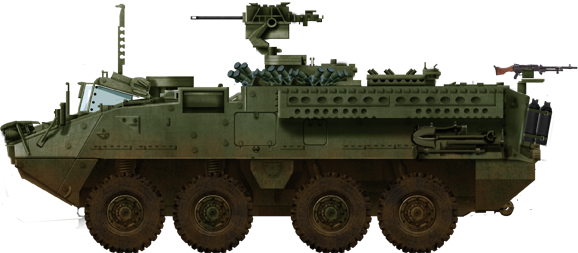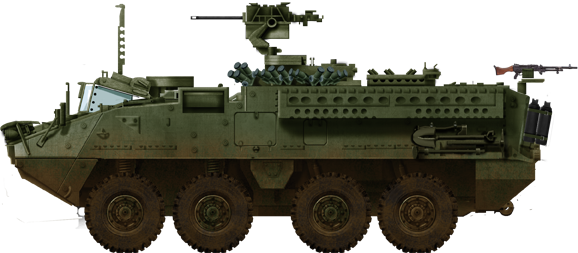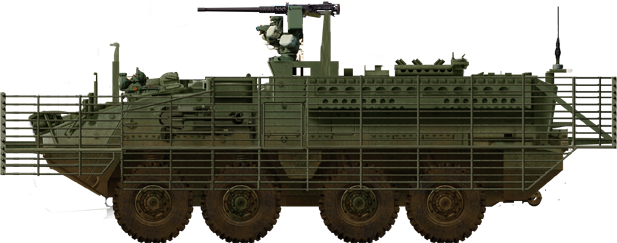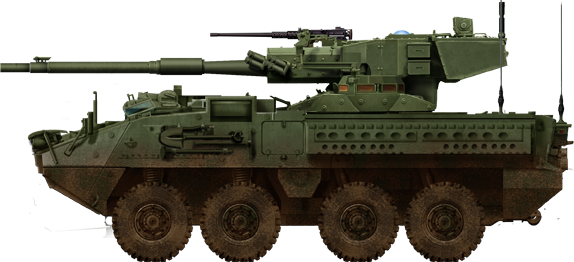
The M1126 Stryker is an 8x8 wheeled armored personnel carrier (APC) used by the United States Army. It is part of the larger Stryker family of vehicles, named after two Medal of Honor recipients, Private First Class Stuart S. Stryker and Specialist Robert F. Stryker. The Stryker series is known for its versatility, mobility, and ability to adapt to various battlefield roles, with the M1126 being the primary variant designed for troop transport. The M1126 Stryker features all-around ballistic protection against 14.5mm armor-piercing rounds, artillery shell fragments, and improvised explosive devices (IEDs). The vehicle's V-shaped hull provides enhanced protection against mines and roadside bombs. It wa slater equipped with a SLAT armor system against RPGs.
Primary armament for the APC is a remote weapons station (RWS) mounting the M2 .50 cal. or MK19 40mm automatic grenade launcher alternative plus M240 7.62mm LMG. For active protection it had sets of smoke grenade launcher. Built by GDLS it was capable of 60 mph (97 km/h) on paved roads with a 330 miles (531 km) and be transported via C-130 Hercules. In short it was believed the prefect vehicle for the Stryker Brigade Combat Team (SBCT) set in place at the same time. The crew of 2 (driver and commander) was completed by 9 infantry soldiers with full gear, multiple hatches and a rear ramp. The vehicle is equipped with advanced communications and battlefield management systems, providing real-time data to enhance situational awareness. Main variants includes the M1128 Mobile Gun System (MGS), M1130 Command Vehicle (CV), M1129 Mortar Carrier (MCV) and M1134 Anti-Tank Guided Missile (ATGM).
The M1126 Stryker APC is essentialy a faster replacement for the M113 better adapted for COIN operations like in Afghanistan and Iraq. Its initial design emphasizes a balance between protection, mobility, and firepower while being modular and flexible, so that the Brigade could be entirely filled with variants of the main vehicle. So far c4900 were delivered from 2001 onwards, and post-combat upgrades over the years such as the Double-V Hull (DVH) to deal with IEDs and mines, 30mm autocannons and the Active Protection Systems (APS), and active protection against missiles and RPGs.
The M1126 Stryker saw action in Iraq and Afghanistan and was proven effective in urban combat and counterinsurgency operations however while being limited in sandy and muddy terrains, especially after the added wieght of upgrades. The whole program was criticized by some however as the concept of Stryker Brigade Combat Team, already at the time and as of 2022 with the return of high intensity warfare and the increased need of better protected, tracked vehicles.

The modern US Army wheeled APC
The M1126 Stryker is loosely based on the previous LAV-III, but shared very little component. The previous vehicle was mostly an USMC armoured personal carrier based on the Canadian LAV-III produced from 1983, and of which 880 entered service. As a derivative of the prolific Piranha APC family from Mowag, which "invented" the modern wheeled modular APC ten year prior, the LAV-25 differed on many points, most prominently its 25 mm M242 Chain Gun and dedicated turret. The "land shark" served in many conflicts but it's now nearing the end of its service in its initial state, pending conversion to the new modernization program, called LAV-ATM (2012).The Army was interested by the concept, until then relying on the tracked M113A3 and M2 Bradley and much smaller HMMVW to carry troops on the battlefield. The USMC experience prompted the development of a vehicle better fitted for the post-cold war environement. The plan started in 1999, October, as General Eric Shinseki, U.S. Army Chief of Staff at that time, outlined the need for a modular, cheaper vehicle to carry troops. Called "Objective Force", it urged the army to adopt a flexible doctrine for quick, multimission deployment, a highly modular vehicle that can be tailored and equipped for a variety of operations in a short notice. The early phase called for the design of an 'Interim Armored Vehicle', filling a capability gap between IFVs such as the M2 Bradley, and light vehicles easy to deploy such as the Humvee.
The Interim Armored Vehicle (IAV) was initially supposed to be temporary until the Future Combat Systems Manned Ground Vehicles program matured enough to give a universal APC, which, of course never happened as it was canceled. As a provisional measure, the combined team of General Motors and General Dynamics were awarded a $8 billion contract in November 2000. They were asked to produce 2,131 vehicles, which were a simple variant of the Canadian LAV III. The very concrete goal was to equip six rapid deployment Brigade Combat Teams. The goal was 2008. United Defense, involved in discussion, protested about the award in December 2000, alleging their own cost was 50% inferior to the GM/GD prposal. It was examined, but rejected by the General Accounting Office in April 2001 and GM/GD proceeded quickly in the development of the new vehicle.
despite the very short timing, the "interim" vehicle was ready deployed in large quantities quie fast, prompting U.S. Assistant Secretary of the Army Paul J. Hoeper to called the IAV projecy "the best off-the-shelf equipment available in the world in this class". Nevertheless over time, comparative statistic shown the vehicle was soon to be underclassed by many international competitors. By February 2002 as production commenced, the Army renamed the IAV (Interim Armored Vehicle) "Stryker", whereas the "I" of Interim was now replaced by "Infantry". But by all measure, this vehicle was truly an APC, now built by General Dynamics Land Systems, and over 5000+ has been manufactured, nearly all for the US. Only Thailand received a few, and three others tested derivatives such as the Mobile Gun System. There were doubts about its price and capabilities, which had persisted until recently.
Design of the M1126

The M1126 ICV in dimensions and general shape is basically a modernized LAV-III, corresponding to the Piranha Mark V, recoignisable to its broken nose. It is 18.16 short tons (16.47 t) and measured 22 ft 10 in (6.95 m) for a width of 8 ft 11 in (2.72 m), height of 8 ft 8 in (2.64 m). Its capacity varies among variants, but the basic APC carries two (driver and commander) plus 9 equipped soldiers. Like the LAV-25, it's a classic configuration freeing the aft compartment, modular, for all sorts of uses. The transmission is in the nose, with the driver seated on the right and engine compartment on its left.
Armament
The commander's post is behind, with a centrally-mounted cupola, and a remote control weapon system, called the Protector RWS, mounting either a 0.50 in (12.7 mm) M2 machine gun or 40 mm Mk 19 grenade launcher. See the variants for other armaments. The IFV for example (Stryker Dragoon) is given the 30 mm Mk44 Bushmaster II gun, and the M1128 tank hunter (Mobile Gun System), a 105 mm gun M68A2 gun (same as for the Abrams M1). This modular combination are thought to organically provide and perform all roles in a rapidly deployable mobile strike force, much more flexible and cheaper to deploy than classic Tracked MBTs and IFVs.The Remote weapon system M151E2 is capable of mounting either the .50cal M2HB MG (2000 rounds in storage) or the 40mm Automatic Grenade Launcher Mk19 MOD3 (480 rounds). The traverse is electric, 360°, with a max traverse rate of 60°/sec. and an elevation of -20 to +55°. It is stabilized in azimuth and elevation, and equipped with a laser rangefinder. The commander had a thermal imager camera and the driver an AN/VAS-5 thermal sight.

Protection
The hull is made of high hard steel and composites, assembled by welding, 14.5 mm resistant on the frontal arc (classified RHA thickness, est. 13 cm or 0.5 inches) with provision to fix add-on armor. Vehicles deployed in Iraq and Afghanistan also were given BAR armor for urban patrols, protecting against RPGs. For active protection, they have sensors, a laser warning system, and illumination system, and six smoke projectors on the RWS. There was a basic mrotection against mines and IFVs, and from 2019, an upgrade program to make them "mine-resistant" started, called DVH (Double V Hull).Propulsion & mobility
The M1126 is propelled by a Caterpillar C7 350 hp (260 kW) engine, publicized as the “golden child” in Caterpillar diesel engine lineup, combining raw horsepower with computer controlled clean emissions. This Caterpillar 3126 unit is a 6-cylinder, 4-cycle inline turbocharged diesel capable of an output of 350 hp at 2500 rpm. It is coupled with an Allison MD 3066P transmission with a 6 speeds forward, 1 reverse gearbox. Steering is hydraulic, applied on both front axles. The Braking system is dual-circuit hydraulic with air-power assist and provided with an anti-lock system on the rear 3 axles.
Its Power/weight ratio for the basic APC is 19.3 hp/sh ton (15.8 kW/tonne) providing for a top speed (max) of 100 kph, and in practice around 97 kph or 60 mph. The vehicle reused the classic LAV-25 drivetrain, with a 8×8 wheeled chassis, with the first two axles are independent and last two fixed, with hydrostrut leaf spring and shock absorbers for each wheel. Its operational range is 310-330 miles (530 km) on road, down to 200 miles all terrain, thanks to a 200 liters or 53 gallons tank. It is amphibious without preparation and air-transportable, although much heavier than the LAV-25.
Ground performances are as follows:
-Level road speed 96 kp
-Trench crossing 78" or 2 meters
-Max grade climbing 60%
-Max slideslope climbing 30%
-Max vertical obstacle 23" or 58 cm
-Minimum turning diameter 52' or 16 meters
-Max fording depth 51" or 1,3 m

Production, Variants and Ugrades of the M1126

Production
So far, the M1126 and its variants saw a production of c4,900 vehicles, including 4,466 for the US Army, the rest for the USMC. In 2002, as it entered service, the Stryker program already faced criticism from lawmakers. One most vocal against this choice was Congressman Newt Gingrich, as well as several Pentagon officials which wanted to halve the Stryker Brigade Combat Teams for a cost saving of $4.5 billion. In October 2002 its air mobility from a C-130 was demonstrated at Andrews Air Force Base. Army CiC Shinseki defended the six-brigade plan, with the enormous advantage offered by this air-portability with the inexpensive C-130.Four brigades were funded in the DoD's budget proposal FY2004. Secretary of Defense Donald Rumsfeld deferred a decision on two additional Brigades though, until July 2003. In May operational capability was tested at Fort Polk. The New York Times that for once, the program had proceed swiftly from 1999. By November 2003, 311 Stryker were sent to the Iraq War, receiving mixed reviews as they were judged not ready yet for frontline combat, and still pressed on in counterinsurgency roles. Experience prompted field upgrades in the armor starteing with GDLS own designed slat armor, at the cost of 5,000 lb (2,270 kg) in overall weight. Thus also ruled out transporting the up-armoured vehicle via a C-130 and complicated maintenance.

In February 2005, Army CiC Gen. Peter J. Schoomaker was optimistic about its use still, notably to the House Armed Services Committee but a leaked U.S. Army report from December 2004 precised it was "effective and survivable only with limitations for use in small-scale contingencies." Given the experience in Mosul, many design flaws were pointed out and precised the direction taken made it getting worse, not better.
The first Organic Brigade Combat Team heavyweight was the Stryker 105 mm M1128 mobile gun system (MGS) entered low-rate initial production in 2005, just for evaluation, full production in 2007, assembled in a new GDLS plant in London, Ontario. The vehicle was connected by military C4I networks. GDLS Robotic Systems division also worked on autonomous navigation for the Stryker under a $237 million contract, until cut in July 2011. The Tank Automotive Research, Development and Engineering Center (TARDEC) tested notably an active magneto rheological suspension from MillenWorks, tested at the Yuma Proving Ground, improving ovcerall stability. By 2011, over 1,000 Stryker were rebuilt by the Anniston Army Depot to the nex post-combat standard (see upgrades).
Upgrades

The Stryker received many "kit" applications to improve its protection: LAV-H: StrykShield situational awareness kit
- Improved semi-active suspension
- Shallow V-shaped underbelly against IEDs
- Additional side armor
- Redesigned hatches (less gaps in the armor)
- Blast-absorbent and mine-resistant seating
- Non-flammable tires
- Remote weapon station fully stabilized to fire underway
- +500 ampere electrical generation for more systems
- New solid-state power distribution system and data bus
- Power plant systems improvements to deal with 1/4 gerater weight.
In March 2011 however it was determined that the new V-hull design was "not suitable" for long missions in Afghanistan's terrain notably due to the tighter driver's compartment and difficult in release the seat to extract an incapacitated driver. In July 2011, some 450 of these Double V-Hull (DVH) variant were ordered, later ported to 742 and 760 in 2012. DVH Strykers had this new hull, increased armor, upgraded suspension and braking, wider tires, blast-attenuating seats, height management system.

Variants


Combat Deployment of the M1126


Sources
 armyrecognition.com
armyrecognition.commilitary.com
strategic-bureau.com
afvdb.50megs.com
wikipedia.org
Gallery
Illustrations

Regular US Army M1126 ICV in green livery

US Army improved M1126 ICV with slat armour kit, Iraq 2012

US Army M1128 MGS in green livery
Photos









M1131 evacuation vehicle








Modern Tanks
Modern MBTs posters

Denel Bagder (2018)

Type 16 MCV (2016)

Gepard 1A2 last rounds 2011

SANDF

Russian AFVs

Main Battle Tanks
